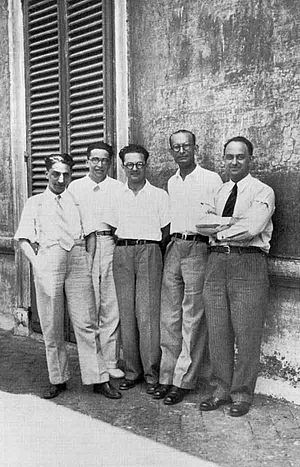Franco Rasetti facts for kids
Quick facts for kids
Franco Rasetti
|
|
|---|---|

Enrico Fermi and his research group (the Via Panisperna boys) in the courtyard of Rome University's Physics Institute in Via Panisperna, about 1934. Franco Rasetti is the second from right
|
|
| Born | August 10, 1901 Castiglione del Lago, Italy
|
| Died | December 5, 2001 (aged 100) Waremme, Belgium
|
| Spouse(s) | Marie Madeline Hennin (m. 1949) |
Franco Dino Rasetti (born August 10, 1901 – died December 5, 2001) was a brilliant scientist from Italy. He later became an American citizen. He was a physicist, meaning he studied how the world works at a very basic level. But he was also a paleontologist (someone who studies fossils) and a botanist (someone who studies plants)!
He worked closely with another famous scientist, Enrico Fermi. Together, they made important discoveries about how atoms can be split, a process called nuclear fission. This work was key to understanding atomic energy. However, Franco Rasetti chose not to work on the Manhattan Project, which was about building the atomic bomb, because he felt it was morally wrong.
Contents
Franco Rasetti's Early Life and Career
Franco Rasetti was born in Castiglione del Lago, Italy. He earned his physics degree from the University of Pisa in 1923. Soon after, Enrico Fermi invited him to join his research team. This team was at the University of Rome.
In 1928 and 1929, Rasetti traveled to the California Institute of Technology (Caltech) in the United States. There, he did experiments on something called the Raman effect. He studied the spectrum of dinitrogen gas. His findings in 1929 were very important. They showed that the idea of the atomic nucleus being made only of protons and electrons was wrong.
In 1930, Rasetti became a professor at the University of Rome. He taught spectroscopy, which is the study of how light interacts with matter. His colleagues included other famous scientists like Oscar D'Agostino, Emilio Segrè, and Ettore Majorana. He stayed in this role until 1938.
Discoveries in Radioactivity
Rasetti was a key partner for Enrico Fermi. They studied neutrons and how they could make things radioactive. This is called neutron-induced radioactivity. In 1934, Rasetti helped discover artificial radioactivity in elements like fluorine and aluminum. This discovery was very important. It helped scientists understand how to develop the atomic bomb.
Leaving Italy and Later Life
By 1939, the political situation in Italy was getting worse due to fascism. Many scientists, including Fermi, Segrè, and Bruno Pontecorvo, left the country. Rasetti also decided to leave. He had helped Fermi discover the key to nuclear fission. But unlike many of his colleagues, he refused to work on the Manhattan Project. He made this choice for moral reasons.
From 1939 to 1947, Rasetti taught at Laval University in Quebec City, Canada. He even helped start the physics department there. In 1947, he moved to the United States. He became an American citizen in 1952. He taught physics at Johns Hopkins University in Baltimore until 1967.
From the 1950s onwards, Rasetti started to focus more on nature. This had been a big interest of his since he was a child. He studied geology, paleontology (fossils), entomology (insects), and botany (plants). He became a leading expert on the Cambrian geological era. This is a very old time in Earth's history.
Franco Rasetti passed away in Waremme, Belgium, when he was 100 years old. An article in the science magazine Nature said he was one of the most prolific generalists. This means he was skilled in many different areas. His work was known for being elegant, simple, and beautiful.
Understanding the Atomic Nucleus with Raman Spectroscopy
When Rasetti was at Caltech in 1928–29, he studied the Raman effect in gases. He looked at how light scattered when it hit gases like hydrogen (H2), nitrogen (N2), and oxygen (O2). He noticed a pattern: some lines in the light spectrum were strong, and others were weak.
Scientists Gerhard Herzberg and Walter Heitler explained this pattern. It had to do with something called nuclear spin isomerism. For hydrogen, the nucleus has a spin of 1/2. This means that certain energy levels were more common, making some lines brighter.
But for nitrogen, Rasetti saw the opposite pattern. This meant that the nuclear spin of nitrogen had to be a whole number. This was a big puzzle at the time. Scientists then thought that the nucleus of nitrogen (14N) had 14 protons and 7 electrons. This would give it a half-integer spin. But Rasetti's experiment showed it must have a whole-number spin.
His Raman spectrum was the first real proof that the proton-electron model of the nucleus was wrong. In 1932, the discovery of the neutron happened. Then, Werner Heisenberg suggested that the nucleus contains protons and neutrons. For 14N, this meant 7 protons and 7 neutrons. This adds up to 14 particles, which gives a whole-number spin. This matched Rasetti's observations perfectly!
Rasetti also made the first observation of electronic Raman scattering in nitric oxide.
Awards and Recognition
- In 1952, Franco Rasetti received the Charles Doolittle Walcott Medal. This award was given by the National Academy of Sciences. He earned it for his important work in Cambrian paleontology.

